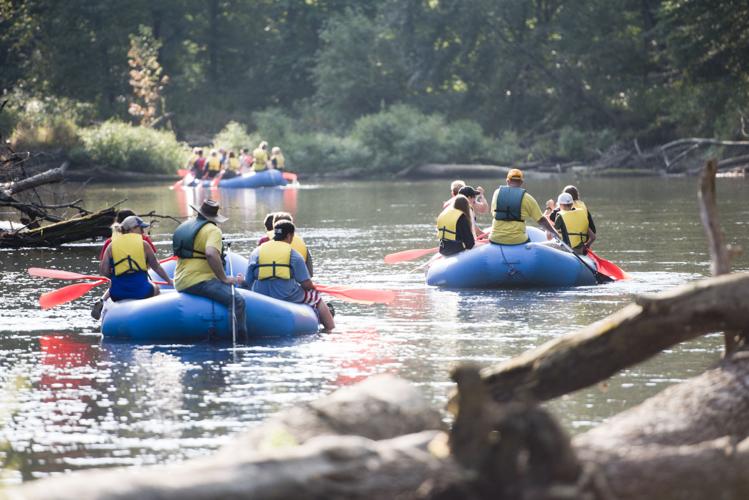Every September for the last 25 years, Arrow Head Country Resource Conservation and Development (RC&D) Education Committee hosts nearly 500 students from the region to partake in an educational rafting expedition on the Tippecanoe River.
As part of the river expedition and academic competition, participating students raft a three-mile section of the river as it flows through the Tippecanoe River State Park in Pulaski County. The students from various schools in the area are assigned to raft teams via color-coded wrist bands where they must work as a team throughout the day.
Darci Zolman, chair of the RC&D education committee, has been involved with the rafting program for all 25 years.
“Arrow Head’s purpose is to connect communities to their natural resources — how to better understand and manage them and how to best use them as part of the community,” Zolman said. “This program connects kids with a lot of great activities.”
Each day begins with an interactive lesson on watersheds. Students investigate the impact of stormwater runoff — the movement of contaminants in addition to erosion impacts — on the local watershed and discuss mitigation strategies to help minimize the negative impacts of runoff.
Watershed instructors guide students, prompting them to consider various solid and liquid contaminants from cars, seepage from landfills, use of fertilizers and pesticides and more. Once students place contaminants over the tarp (sprinkles representing sediment, soy sauce representing oil, etc.), a spray bottle is used to represent rain. After spraying the tarp with water, students are able to visualize the runoff and contaminants moving throughout the watershed, draining into lakes and rivers.
The Tippecanoe watershed is part of the Wabash watershed, which is part of the Ohio watershed, which is part of the Mississippi watershed, which drains into the Gulf of Mexico.
The next portion of the competition includes a lesson on forestry. Students are taught the value in managing forest lands for multiple uses by recognizing the land can be managed to enhance wildlife habitat, aesthetics and protect soil and water quality at the same time.
The lesson gives students the chance to learn from professional foresters — helping them learn tree identification techniques, understand the value of a properly managed forest and have a greater appreciation of forest land as a renewable natural resource.
Zolman said that even without the academic side of the event, just being outside can make a positive impact on young students.
“I think that just being outdoors has a lot of benefit on these students,” said Zolman. “There are all kinds of studies that show the benefits to developing decision making, problem solving and working as a team.”
After the forestry portion of the competition is complete, students load up in their rafts with their assigned teams for a voyage down the Tippecanoe River. Raft instructors are assigned to each raft, sharing information about the river, the riparian zones surrounding it, plant species, soils, potential issues, conservation practices and more.
While raft instructors are guiding and teaching students about multiple topics, Zolman says they are always on the lookout for “teachable moments.”
“All the way down we are looking for teachable moments,” she noted. “Whether it’s picking out plants that are unique, or if we see otters, we identify birds like herons and eagles, we talk about soils — one of my personal goals is to make a connection between land and water.”
Stops are then made along the river, where students learn about the importance of water testing. They conduct chemical water tests (phosphate and nitrate), learning that high levels of nutrients in a body of water can result in biological, health and economic impacts, including loss of plant, invertebrate and fish diversity.
Students complete their biological assessment of the river based on macro-invertebrates that they net. Generally, waterbodies in healthy biological condition support a wide variety and high number of macroinvertebrates, including many that are intolerant of pollution. Samples yielding only pollution-tolerant species or very little diversity or abundance may indicate a less healthy waterbody.
The Tippecanoe River was identified by the Nature Conservancy as one of the most ecologically diverse in the nation. They consider it as one of the top 10 rivers in the United States to be preserved due to its ecological diversity and the high proportion of endangered species housed there. According to the group, four of the 12 state endangered fish species can be found there. The river also maintains 49 of the 57 freshwater mussel species it historically had including slippershells and salamander mussels.
Zolman said that we’re lucky to have these kinds of resources right in our backyards. It’s one the main messages she tries to relay to the students involved in the rafting program.
“It’s so important to teach them about the natural resources in their own backyards, along with helping them realize they can play a part in protecting them,” she said.
Andrea Surma is also a member of the RC&D education committee and has been alongside Zolman during all 25 years of the rafting program. She said that the program’s project-based learning has a positive impact on the education of the students involved, offering a quote from Benjamin Franklin.
“As they say, ‘tell me and I forget, teach me and I may remember, involve me and I learn,” Surma said. “You’re outside doing things, and not just reading.”
Zolman and Surma estimate the rafting trip has hosted over 12,000 students over the years, averaging anywhere from 400-500 students per year.
“I had a teacher in my raft the other day that came on this trip as a freshman in high school,” Zolman said. “I was like ‘really? That’s crazy.’”
The river expedition is open to students in grades 9-12 in Arrow Head RC&D’s 10-county boundaries: Cass, Fulton, Jasper, Kosciusko, Marshall, Miami, Newton, Pulaski, Starke and White counties.
Zolman said that her favorite memories from the program’s 25 years are the “light bulb moments” students have while on the trip.
“For me it’s the light bulb moments with kids — maybe it’s the first time they’ve ever seen an otter on the river,” Zolman said. “It’s just exciting to see them get engaged — once it clicks with them, it’s like magic.”






























Commented
Sorry, there are no recent results for popular commented articles.